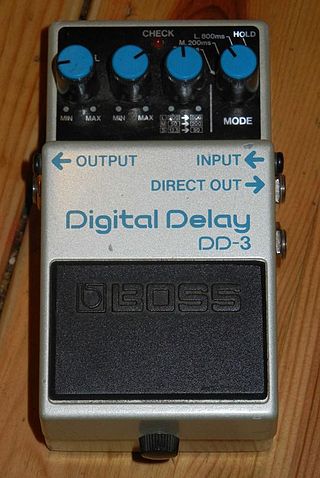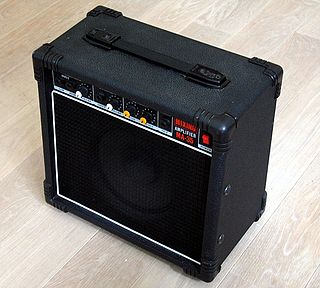
An effects unit, effects processor, or effects pedal is an electronic device that alters the sound of a musical instrument or other audio source through audio signal processing.

MIDI is a technical standard that describes a communication protocol, digital interface, and electrical connectors that connect a wide variety of electronic musical instruments, computers, and related audio devices for playing, editing, and recording music.

A game controller, gaming controller, or simply controller, is an input device or input/output device used with video games or entertainment systems to provide input to a video game. Input devices that have been classified as game controllers include keyboards, mice, gamepads, and joysticks, as well as special purpose devices, such as steering wheels for driving games and light guns for shooting games. Controllers designs have evolved to include directional pads, multiple buttons, analog sticks, joysticks, motion detection, touch screens and a plethora of other features.

A groovebox is a self-contained electronic or digital musical instrument for the production of live, loop-based electronic music with a high degree of user control facilitating improvisation. The term "Groovebox" was originally used by Roland Corporation to refer to its MC-303, released in 1996. The term has since entered general use, and the concept dates back to the Movement Computer Systems Drum Computer in 1981.

An electronic keyboard, portable keyboard, or digital keyboard is an electronic musical instrument based on keyboard instruments. Electronic keyboards include synthesizers, digital pianos, stage pianos, electronic organs and digital audio workstations. In technical terms, an electronic keyboard is a synthesizer with a low-wattage power amplifier and small loudspeakers.

A rhythm section is a group of musicians within a music ensemble or band that provides the underlying rhythm, harmony and pulse of the accompaniment, providing a rhythmic and harmonic reference and "beat" for the rest of the band. The rhythm section is often contrasted with the roles of other musicians in the band, such as the lead guitarist or lead vocals whose primary job is to carry the melody.

A MIDI controller is any hardware or software that generates and transmits Musical Instrument Digital Interface (MIDI) data to MIDI-enabled devices, typically to trigger sounds and control parameters of an electronic music performance. They most often use a musical keyboard to send data about the pitch of notes to play, although a MIDI controller may trigger lighting and other effects. A wind controller has a sensor that converts breath pressure to volume information and lip pressure to control pitch. Controllers for percussion and stringed instruments exist, as well as specialized and experimental devices. Some MIDI controllers are used in association with specific digital audio workstation software. The original MIDI specification has been extended to include a greater range of control features.

A sound module is an electronic musical instrument without a human-playable interface such as a piano-style musical keyboard. Sound modules have to be operated using an externally connected device, which is often a MIDI controller, of which the most common type is the musical keyboard. Another common way of controlling a sound module is through a sequencer, which is computer hardware or software designed to record and playback control information for sound-generating hardware. Connections between sound modules, controllers, and sequencers are generally made with MIDI, which is a standardized interface designed for this purpose.

Bass pedals are an electronic musical instrument with a foot-operated pedal keyboard with a range of one or more octaves. The earliest bass pedals from the 1970s consisted of a pedalboard and analog synthesizer tone generation circuitry packaged together as a unit. The bass pedals are plugged into a bass amplifier or PA system so that their sound can be heard. Since the 1990s, bass pedals are usually MIDI controllers, which have to be connected to a MIDI-compatible computer, electronic synthesizer keyboard, or synth module to produce musical tones. Some 2010s-era bass pedals have both an onboard synth module and a MIDI output.

A MIDI keyboard or controller keyboard is typically a piano-style electronic musical keyboard, often with other buttons, wheels and sliders, used for sending Musical Instrument Digital Interface (MIDI) signals or commands over a USB or MIDI 5-pin cable to other musical devices or computers. MIDI keyboards lacking an onboard sound module cannot produce sounds themselves, however some models of MIDI keyboards contain both a MIDI controller and sound module, allowing them to operate independently. When used as a MIDI controller, MIDI information on keys or buttons the performer has pressed is sent to a receiving device capable of creating sound through modeling synthesis, sample playback, or an analog hardware instrument. The receiving device could be:

The Korg MS-20 is a patchable semi-modular monophonic analog synthesizer which Korg released in 1978 and which was in production until 1983. It was part of Korg's MS series of instruments, which also included the single oscillator MS-10, the keyboardless MS-50 module, the SQ-10 sequencer, and the VC-10 Vocoder. Additional devices included the MS-01 Foot Controller, MS-02 Interface, MS-03 Signal Processor, and MS-04 Modulation Pedal.
Arturia is a French electronics company founded in 1999 and based in Grenoble, France. The company designs and manufactures audio interfaces and electronic musical instruments, including software synthesizers, drum machines, analog synthesizers, digital synthesizers, MIDI controllers, sequencers, and mobile apps.

Delay is an audio signal processing technique that records an input signal to a storage medium and then plays it back after a period of time. When the delayed playback is mixed with the live audio, it creates an echo-like effect, whereby the original audio is heard followed by the delayed audio. The delayed signal may be played back multiple times, or fed back into the recording, to create the sound of a repeating, decaying echo.

Distortion and overdrive are forms of audio signal processing used to alter the sound of amplified electric musical instruments, usually by increasing their gain, producing a "fuzzy", "growling", or "gritty" tone. Distortion is most commonly used with the electric guitar, but may also be used with other electric instruments such as electric bass, electric piano, synthesizer and Hammond organ. Guitarists playing electric blues originally obtained an overdriven sound by turning up their vacuum tube-powered guitar amplifiers to high volumes, which caused the signal to distort. While overdriven tube amps are still used to obtain overdrive, especially in genres like blues and rockabilly, a number of other ways to produce distortion have been developed since the 1960s, such as distortion effect pedals. The growling tone of a distorted electric guitar is a key part of many genres, including blues and many rock music genres, notably hard rock, punk rock, hardcore punk, acid rock, and heavy metal music, while the use of distorted bass has been essential in a genre of hip hop music and alternative hip hop known as "SoundCloud rap".

An electronic drum module is an electronic or digital music device in an electronic drum kit that serves as the central processing unit and sound module. The drum module creates or produces the drum kit sounds or other sounds selected by the drummer. By itself, a drum module cannot play or sound drum beats. It only produces drum sounds when a performer strikes electronic drum pads or acoustic drum kit instruments that have electronic "triggers" attached to them. When the electronic drum pads or trigger-equipped instruments are struck, this sends a signal to the drum module, which produces the corresponding electronic drum sound. Even when drum pads and/or triggers are connected to a drum module, the drum module by itself does not make any audible sound. Like other electronic instruments such as the synthesizer, the drum module only outputs an electronic signal. The performer can hear this signal by connecting headphones to the drum module or by plugging the drum module into an amplifier and loudspeaker or PA system for audible practice or live performances. The drum module's output signal can also be patched into an audio console for concerts or sound recording. The nomenclature varies. For example, electronic drum modules are called "percussion sound modules" in the case of Roland Corporation, or sometimes simply modules. A common colloquial term for this device is drum brain..

This is a glossary of jazz and popular music terms that are likely to be encountered in printed popular music songbooks, fake books and vocal scores, big band scores, jazz, and rock concert reviews, and album liner notes. This glossary includes terms for musical instruments, playing or singing techniques, amplifiers, effects units, sound reinforcement equipment, and recording gear and techniques which are widely used in jazz and popular music. Most of the terms are in English, but in some cases, terms from other languages are encountered.

A keyboard amplifier is a powered electronic amplifier and loudspeaker in a wooden speaker cabinet used for the amplification of electronic keyboard instruments. Keyboard amplifiers are distinct from other types of amplification systems such as guitar amplifiers due to the particular challenges associated with making keyboards sound louder on stage; namely, to provide solid low-frequency sound reproduction for the deep basslines that keyboards can play and crisp high-frequency sound for the high-register notes. Another difference between keyboard amplifiers and guitar/bass amplifiers is that keyboard amps are usually designed with a relatively flat frequency response and low distortion. In contrast, many guitar and bass amp designers purposely make their amplifiers modify the frequency response, typically to "roll-off" very high frequencies, and most rock and blues guitar amps, and since the 1980s and 1990s, even many bass amps are designed to add distortion or overdrive to the instrument tone.

The Yamaha DX21 is a digital controlled bi-timbral programmable digital FM synthesizer with a four operator synth voice generator which was released in 1985. It uses sine wave-based frequency modulation (FM) synthesis. It has two FM tone generators and a 32-voice random-access memory (RAM), 32 user voices and 128 read-only memory (ROM) factory preset sounds. As a programmable synth, it enables users to create their own unique synthesized tones and sound effects by using the algorithms and oscillators. The instrument weighs 8 kg (17.6 lbs). On its release, it sold for $795.

A digital accordion is an electronic musical instrument that uses the control features of a traditional accordion to trigger a digital sound module that produces synthesized or digitally sampled accordion sounds or, in most instruments, a range of non-accordion sounds, such as orchestral instruments, pipe organ, piano, guitar, and so on. Digital accordions typically encode and transmit key presses and other input as Musical Instrument Digital Interface (MIDI) messages. Most digital accordions need to be plugged into a keyboard amplifier or PA system to hear their sounds.
The 12 Step foot controller is a bass pedal-style programmable MIDI controller pedal keyboard made by Keith McMillen Instruments which was released in 2011. It has small, soft, rubbery keys that are played with the feet. As a MIDI controller, it does not make or output any musical sounds by itself; rather, it sends MIDI messages about which notes are played to an external synth module or computer music program running on a laptop or other computer. Each key on the 12 Step senses the velocity, aftertouch pressure, and the amount of tilt the player is applying with her feet. The messages from the player's foot presses can be sent via USB to a computer-based virtual instrument or to a synthesizer or other electronic or digital musical instrument.



















